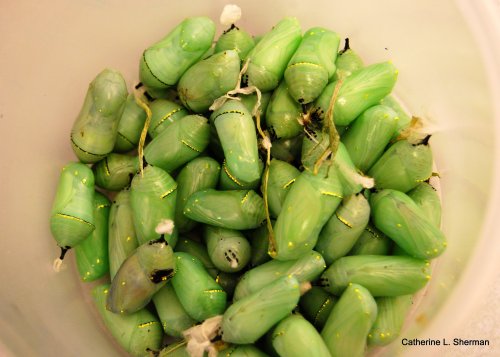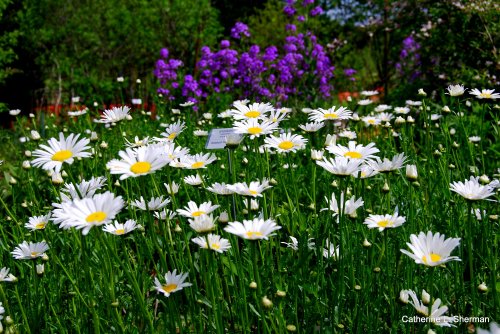
Gimme Shelter! A monarch butterfly escapes the rain in the greenhouse at the annual Monarch Watch fall open house on the University of Kansas campus.
You can’t keep butterfly lovers away, even when it’s raining. More than a thousand people, a lot of them children, showed up for the annual Monarch Watch fall open house on Sept. 6 at Foley Hall at the University of Kansas in Lawrence. That’s almost twice the usual number of visitors, according to entomologist Orley “Chip” Taylor, director of Monarch Watch.

Newly hatched Monarch butterflies cling to Chip Taylor’s face and hat as they harden their wings.
The butterflies weren’t very active because of the damp weather, but the caterpillars still munched away on their favorite plants. Caterpillars can be picky eaters, something children can identify with. For example, the Monarch butterfly caterpillar will only eat milkweed plants, which contain poisons that make the Monarch toxic to animals that might eat it. Fortunately, there are more than 140 species of milkweed. Unfortunately, there are fewer milkweed plants every year because of habitat destruction.
Taylor created Monarch Watch in 1992 to educate people about and to foster the conservation of Monarchs in North America. What Monarchs need most is a place to live and plants to eat in both their larval and adult phases.
“We’re losing 6,000 acres of viable habitat every day to development,” Taylor says.
Monarch Watch educates thousands of students and adults every year about Monarch migration, tagging, milkweed favorites, the life cycle of the Monarch and more.
The program encourages people to create pollinator habitats in their gardens.
“If you create the right environment, pollinators will come,” Taylor says.

Visitors stroll through the Certified Pollinator Garden during the annual open house at the Monarch Watch Headquarters.
Why should we care about pollinators? According to the organization Pollinator Partnership, almost 80 percent of the world’s food crop plants depend on pollination. Birds, bats and insects, such as bees, butterflies, beetles and mosquitoes, transfer pollen from flower to flower. Without them, there wouldn’t be much for people to eat.
Last year, I had to hand pollinate my acorn squash with a paint brush because there weren’t enough pollinators to do the job. I learned a lot about the sex life of squash. Since then, I’ve planted a lot of plants to attract bees and butterflies. These plants produce beautiful blooms, so we can enjoy them, too. Birds can also eat the seeds.
In addition to providing nectar plants, gardeners (that means everyone with a yard) should provide food plants for caterpillars. They need to eat, too. The caterpillar eating your parsley or dill will transform into a gorgeous black swallowtail butterfly, so don’t kill it.

More than 450 monarch butterfly chrysalides were given to children so they could watch a butterfly emerge. Here, Chip Taylor tells parents that 100 more will be available soon.
Years ago I did kill some black swallowtail butterfly caterpillars that were chewing through my parsley. I didn’t know what these caterpillars were, but ignorance is no excuse. Still, humans seem to have a natural revulsion to creepy crawly creatures, particularly those on their food plants. We need to resist that and learn more about these useful creatures. The sad thing is that I rarely use much parsley, anyway. Now, I plant parsley and fennel just for caterpillars as seen in my post on Black Swallowtail butterflies and caterpillars.
I don’t kill caterpillars anymore, although I might make an exception for the tomato hornworm, which can devastate a tomato plant. I saw a tomato hornworm on a tomato plant in the greenhouse at the open house. I thought: They’re even raising hornworms! The tomato hornworm, which can grow up to four inches long, turns into a hawkmoth, which almost looks like a hummingbird from a distance.

A Certified Pollination Garden at Monarch Watch at KU shows visitors what kinds of plants attract pollinators.
This month, Monarch butterflies east of the Rocky Mountains begin their long migration to mountain forests in Mexico, where they spend the winter. Unlike most other insects in temperate climates, Monarch butterflies can’t survive a long, cold winter. Monarch butterflies travel up to three thousand miles, much farther than all other tropical butterflies. Amazingly, they fly in masses to the same winter roosts, often to the same trees, according to Monarch Watch.
Somehow, the Monarchs know their way, even though the butterflies returning to Mexico (or California for west coast Monarchs) each fall are the great-great-great grandchildren of the butterflies that left the previous spring, according to Taylor. No one knows exactly how this homing system works. Taylor talks about the Monarch migration and tagging Monarchs is this 2006 story. New York Times story about Monarch Watch and the Monarch Butterfly Migration. Monarch Watch volunteers will be tagging Monarch butterflies east of Lawrence this month. Taylor expects numbers to be lower than previous years, possibly because of a cooler spring.

Chip Taylor demonstrates how to hold a Monarch butterfly for tagging.
The last Monarch hatch of the season is biologically and behaviorally different from earlier generations in the summer. It won’t mate or lay eggs until the following spring. It must fatten on nectar to make the long journey. That’s why providing nectar flowers is so important.
Monarch Watch helps people to create certified pollination gardens and waystations that provide the right mix of nectar and food plants. So far, more than 2,000 waystations have been certified, but many more are needed to provide resources throughout the year for monarchs as they move across the continent, Taylor says. The waystations are also home to many other insect species, as well as birds.
Taylor and the members of Monarch Watch are advocates for all wildlife. I first interviewed Taylor thirty years ago for a story about killer bees, so he knows about insects with a bad reputation, too. As we move around and alter the landscape, we alter the mix of insects and animals that can live there. Human activity sometimes makes it harder for the beneficial insects to survive.
“We use the charisma of Monarch butterflies to get people interested in other pollinators,” he says. What’s good for pollinators is also good for other animals.

This honeybee finds nectar on a tropical milkweed in the pollination garden at Monarch Watch on the KU campus.
Leave some wild areas in your yard, he suggests.
“Some people get into trouble with their neighbors for creating a more diverse, abundant landscape,” Taylor says. “But a wild and wooly garden provides a lot of food and protection for wildlife.”
City and suburban dwellers are often afraid of wildlife, but Taylor assures people that most pollinators aren’t dangerous.
“You practically have to pick up a bee in your hands to get stung,” he says.
Some public and private institutions are taking the lead. The Kansas Department of Transportation has greatly reduced mowing along the right of way of some of its highways to restore the native grasses and wildflowers there.
The Sprint World Headquarters in Overland Park, Kansas, has restored sixty acres of its campus to natural prairie.
Among good sources of nectar:
- impatiens
- marigolds
- lilacs
- azaleas
- sunflowers
- ageratum

Scary and beautiful is this Pipevine Butterfly caterpillar in the Monarch Watch greenhouse.
- asters
- butterfly bushes
- purple coneflowers
- zinnias
Caterpillar food plants include:
- milkweeds
- hackberry trees
- snapdragons
- willows
- hollyhocks
- members of the carrot family
- thistles
To learn more go to www.pollinator.org or www.monarchwatch.org




























































